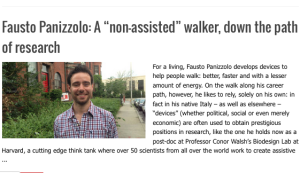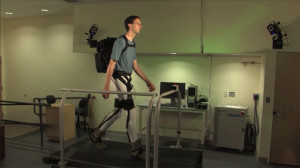 For a living, Fausto Panizzolo develops devices to help people walk: better, faster and with a lesser amount of energy. On the walk along his career path, however, he likes to rely, solely on his own: in fact in his native Italy – as well as elsewhere – “devices” (whether political, social or even merely economic) are often used to obtain prestigious positions in research, like the one he holds now as a post-doc at Professor Conor Walsh’s Biodesign Lab at Harvard, a cutting edge think tank where over 50 scientists from all over the world work to create assistive technology (from heart valves to mechanic gloves) using so-called soft robotics, in other words materials that adapt to the human body rather than encasing it in rigid plastic or metal structures.
For a living, Fausto Panizzolo develops devices to help people walk: better, faster and with a lesser amount of energy. On the walk along his career path, however, he likes to rely, solely on his own: in fact in his native Italy – as well as elsewhere – “devices” (whether political, social or even merely economic) are often used to obtain prestigious positions in research, like the one he holds now as a post-doc at Professor Conor Walsh’s Biodesign Lab at Harvard, a cutting edge think tank where over 50 scientists from all over the world work to create assistive technology (from heart valves to mechanic gloves) using so-called soft robotics, in other words materials that adapt to the human body rather than encasing it in rigid plastic or metal structures.
Fausto is just as interested in the physical devices he works with as he is not in the abovementioned career-advancing metaphorical ones, and he makes it very clear: “let me come closer as I say this,” he tells me as he leans toward the iphone I use as a recorder for the interview, “all I have done to get where I am was knocking on doors; sometimes even with my head, but always in a straightforward ‘non-assisted’ way. Here, at Harvard, it doesn’t matter who you are related to or a friend of; so if that door was opened to me … I was probably qualified to enter.”
At only 33 years of age, this biomedical engineer from Padova – who, as slender and athletic as he is, looks even younger – has good reasons to be proud of his accomplishments, especially because, “ I only have my parents to thank,” as he said even closer to the mic; yet, as soft spoken as he is, the sound never came out saturated – neither physically nor metaphorically. In fact a good deal of modesty- of the genuine kind – matches his pride for a self-made adventure in research, specialized in the computerized analysis of body movement, that already brought him to Canada (where he helped develop sporting shoes) back to Padova (where he studied the dynamics of skiing) and Australia where during his doctorate he worked with patients suffering from heart disease. Ultimately, though, his research and final dissertation at the prestigious St Anna institute of Pisa centered on hand models.
Even though at the cutting edge of human movement research – in fact so cutting edge a lot of it is surrounded by secrecy and inaccessible to outsiders – Fausto shuns away from high sounding comparisons like the one I made at some point to Leonardo da Vinci, as the pioneer in the field of human anatomy in relation to machines. “Let us not exaggerate,” he says gazing out the window of his red brick Cambridge apartment where he has been since last November, overlooking the neighborhood (half way between Harvard and MIT) probably hosting the highest number of scientists per square mile in the world: after all this is the heart of the global Mecca of research; he knows it and loves every minute of it. Yet he does not sound too cocky about it, only extremely enthusiastic. “My job here is simply to figure out how people walk, and help the builders of our devices make the adjustments.”
The devices in question are basically “pants with an engine” as he calls them, a soft external skeleton that understands what the user wants to do and, through a system of sensors and wires complementing the legs’ muscles, enhance every step by accompanying the natural movement and allowing the walker to save energy in the process. “Our prototype can reduce the load on a walker’s back up to 5-6 kg,” he says as his smiling green eyes progressively light up in excitement, “it might not sound like much but nobody in the world has ever done better.”
Of course, once perfected, the potential users for this kind of technology are in the millions: from elderly patients with various walking impairments to stroke victims with partial paralysis all the way to first responders carrying the injured or simply military personnel carrying loaded back packs on the battlefield.
“Walking is a much more complicated operation than we might think,” continues Fausto while trying to compensate my ignorance in the field with detailed computer images and presentations from his past and present work. “Each one of us instinctively chooses a walking pace because that is the exact speed at which he or she spends the smallest amount of energy: believe it or not going slower will use up more “fuel” – or oxygen consumption, which is what the Biodesign Lab uses as a gauge of the energy spent for walking. Each one of us is different,” continues the researcher who, at this point is an unstoppable explaining machine, “and the goal is to develop a device that can adapt to all. The field is absolutely fascinating, and is only in its infancy.”
In other words this research has a long road ahead, and therefore, so does Fausto, who is indeed ready to walk it all “device-free”. Yet the ‘Mecca’ comes with a price tag: “I still haven’t gotten used to the intensity of the work, around here: I barely have time to eat!”. Let alone, he adds, for writing children books or playing magician and clown for hospitalized children – a hobby he says that gives him more satisfaction than publishing research papers. But even though the pace at Harvard might be a little faster than Perth, where he held his former post for four years at the University of Western Australia, at least, he reckons, “by comparison is around the corner from home.”

